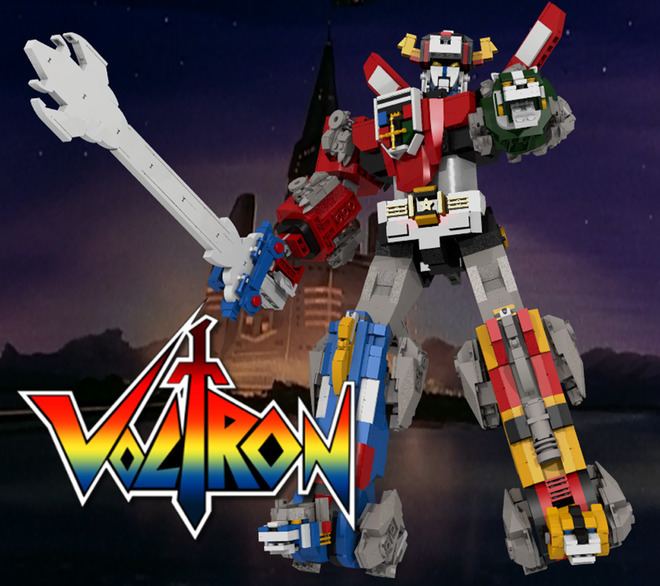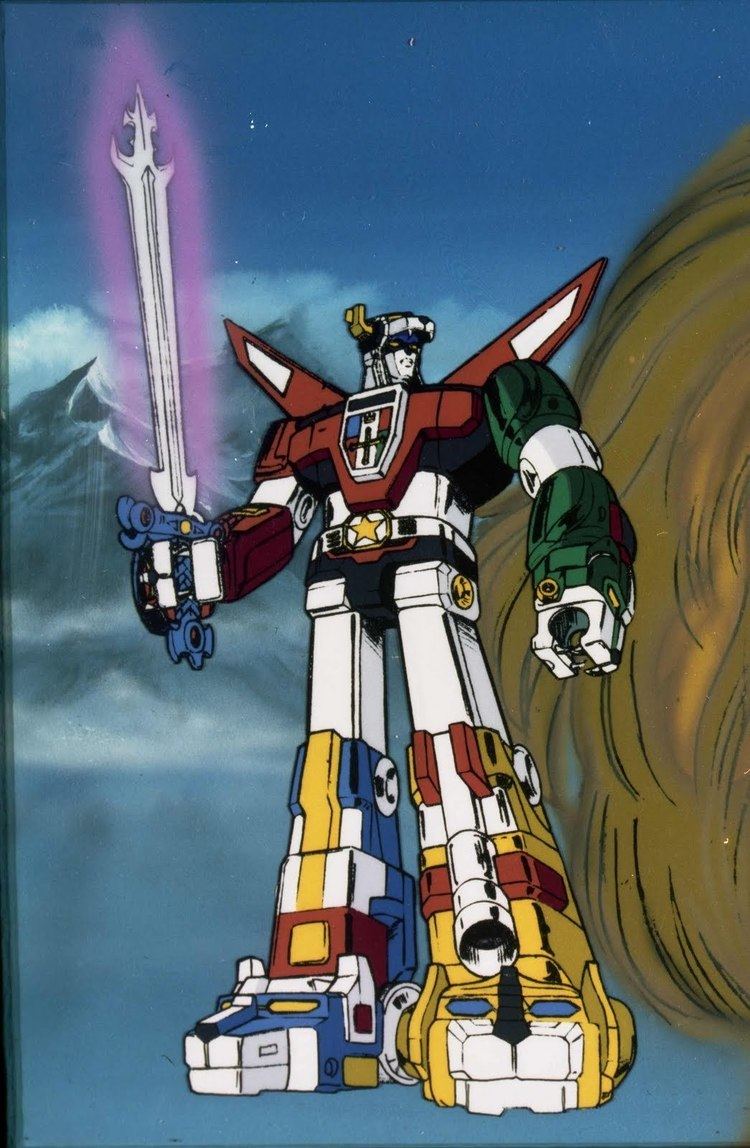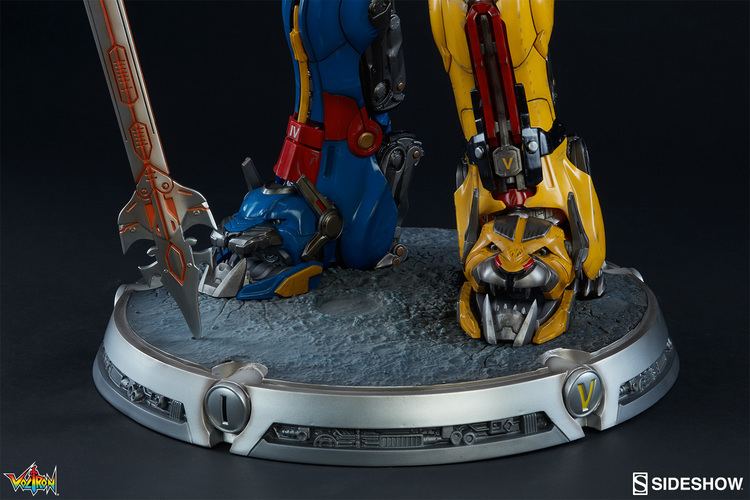8 /10 1 Votes
Directed by Fraklin Cofod Music by Dale Schacker Final episode date 18 November 1985 Number of episodes 124 | 8/10 IMDb Produced by Steve Sterling First episode date 10 September 1984 Program creator Toei Animation Number of seasons 3 | |||||||||||||||||||||||||||||||||
Genre Science fiction, Adventure, Mecha Written by Jameson Brewer
(developer for American television) Studio World Events Productions
Toei Animation (epis. 1–52) Cast Peter Cullen, Neil Ross, B J Ward, Michael Bell, Jack Angel Similar Voltron Force, Voltron: The Third Dimension, Saber Rider and the Star S, He‑Man and the Masters o, Astro Boy Profiles | ||||||||||||||||||||||||||||||||||
Voltron: Defender of the Universe is an American-Japanese animated television series that features a team of astronauts who pilot a giant Super Robot known as "Voltron". Initially produced as a joint venture between World Events Productions and Toei Animation, the original television series aired in syndication from September 10, 1984 to November 18, 1985. The first season of Voltron, featuring the "Lion Force Voltron", was adapted from the Japanese anime television series Beast King GoLion. The second season, featuring the "Vehicle Team Voltron", was adapted from the unrelated anime series Armored Fleet Dairugger XV.
Contents
- Voltron legendary defender official trailer hd netflix
- Development
- Lion Force Voltron Voltron of the Far Universe Voltron III
- Vehicle Team Voltron Voltron of the Near Universe Voltron I
- Gladiator Voltron Voltron of the Middle Universe Voltron II
- Subsequent projects
- DVD releases
- Digital releases
- 1980s
- 2000s
- Matchbox
- Panosh Place
- Trendmasters
- Toynami
- Mattel
- Playmates Toys
- Other merchandise
- Video games
- Changes from the Japanese version
- GoLion
- Animation staff
- References

Voltron was the top-rated syndicated children's show for two years during its original run, and spawned two follow-up series, several comic books, and a 1-hour special.

Voltron legendary defender official trailer hd netflix
Development

The original series was created by Peter Keefe and John Teichmann, founding partners of World Events Productions, in 1984 using material that they had licensed from the Japanese animated series Beast King GoLion and Armored Fleet Dairugger XV. But since they had no means of translating the Japanese series into English, Keefe and Teichman surmised the plots, commissioned writer Jameson Brewer to write all-new dialogue, edited out the more violent scenes, and remixed the audio into stereo format. The series was an immediate hit in the United States, topping the syndication market for children's programs in the mid-1980s.

The Japanese Future Robot Daltanious series was originally planned to be adapted by World Events Productions as part of Voltron. When requesting master tapes from Toei Animation for translation purposes, the World Events Productions producers requested "[the] ones with the lion." Mistakenly, Toei then proceeded to ship World Events copies of Beast King GoLion, another "combining-robot" cartoon which featured lion-shaped fighting robot starships.. Because the World Events producers greatly preferred GoLion to Daltanious, the GoLion episodes were adapted instead, going on to become the most popular portion of the original Voltron run. A third version/series of Voltron based on yet another Japanese series, Lightspeed Electroid Albegas, was also in progress, but dropped when World Events Productions joined with Toei to make new GoLion-based shows, due to that show's popularity over the Dairugger run.
Lion Force Voltron (Voltron of the Far Universe; Voltron III)

The first series was edited primarily from Beast King GoLion (Hyakujû-ô Goraion), and features a team of five young pilots commanding five robot lions which can be combined to form Voltron. In this undefined future era, the Voltron Force is in charge of protecting the planet Arus (ruled by Princess Allura) from the evil King Zarkon (from planet Doom), his son Lotor, and the witch Haggar, who creates huge "ro-beasts" to terrorize the Arusian people. Despite being the first of the two robots to appear on American television, the "GoLion" version of Voltron was regarded as "Voltron III" within the storyline because, within the original planned "three-Voltron" continuity, Arus was the furthest setting from Earth's side of the universe ("Voltron I" being intended for the Near Universe, and "Voltron II" for the Middle Universe).
Vehicle Team Voltron (Voltron of the Near Universe; Voltron I)
The second series was edited primarily from Armored Fleet Dairugger XV (Kikô Kantai Dairugger XV), with the storyline considerably changed. In this iteration of Voltron, the Galaxy Alliance's home planets are now overcrowded, and a fleet of explorers is sent to search for new planets to colonize. Along the way, they attract the attention of the evil Drule Empire, long engaged in an ongoing war against the Alliance, and the Drules proceed to interfere with the mission of the explorers and the colonists. Since the Arusian Voltron is too far away to help these explorers, a totally new Voltron has to be constructed to battle the Drule threat.
This Voltron Force consists of fifteen members, divided into three teams of five, known respectively as the Land, Sea, and Air Teams. Each team is specialized in gathering data or fighting in their area of expertise. Each team can combine their vehicles into a bigger machine, with each combined vehicle differing among the three teams. These fighters are:
When necessary, all fifteen vehicles combine to form the mighty Voltron. This Voltron in the toyline was referred to as Voltron I as it was set closest to Earth. However, the assembly of the Vehicle Team Voltron could not be maintained for longer than five minutes at a time; it was explained in the first episode that when combined Voltron only had enough stored solar energy to operate for five minutes.
Gladiator Voltron (Voltron of the Middle Universe; Voltron II)
The proposed third season was to have been based on Lightspeed Electroid Albegas (Kosoku Denjin Albegas). Although Matchbox did produce and market toy versions of the three robots (Black Alpha, Red Gamma, Blue Beta) under the "Voltron II" name, the series never actually aired. Due to the extreme popularity of the Lion Force Voltron and lack of popularity of the Vehicle Team Voltron series, World Events Productions eventually elected against another alternate Voltron, and plans to adapt Albegas were aborted.
Subsequent projects
DVD releases
In Australia, DVDs of all episodes of Voltron were released by Madman Entertainment as the 20th Anniversary Edition, Lion Force Voltron Collection. The original series was released in five volumes between August 2004 and July 2005, under the name Voltron: Defender of the Universe. Each box was in the color and style of one of the lions with a metallic glossy inner DVD-case. Another three volumes of "Vehicle Team Voltron" were released between August and December 2005. In addition, a "Best of" 2-DVD set released in November 2006 featured five episodes from each series. Finally, a 24-disc boxset subtitled The Lion and Vehicle Force Complete Collection was released on June 24, 2009. Madman Entertainment has since relinquished the rights to the Voltron series and has since been re-released by Beyond Home Entertainment. Previous licensees of Voltron in Australia have been CBS/Fox Video and Manga Entertainment.
Prior to the release of the boxed sets, a promotional DVD was released for Voltron. It was packed in a threefold glossy cardboard folder. The folder featured full-color artwork and text about the then-upcoming release of Voltron on DVD. The disk had an image of Voltron, and was labeled for promotional use only. It featured the first episode, "Space Explorers Captured", and several promos for other series.
In Region 1, Voltron was released on DVD in its original broadcast form and remastered by New York–based distributor Media Blasters in eight volumes between September 2006 and July 2009. The volumes contain approximately fifteen episodes each, along with special features such as interviews with producer and director Franklin Cofod, and various others involved in the original and current productions. The first five volumes together contain all the Lion Force episodes, which were broadcast as seasons 1 and 3, while the next three contain the Vehicle Team episodes, broadcast as season 2.
The Fleet of Doom special was released on DVD early in 2007, as an online Voltron.com exclusive. Fleet of Doom was a special crossover film where the Vehicle and Lion Voltrons joined forces to defeat the "Fleet of Doom" (Doom and Drule Empires). The special was originally released in 1986, but was never released in Japan. Media Blasters released Fleet of Doom on July 28, 2009 as a full retail release. A Blu-ray version was planned, but it was delayed many times and was finally officially canceled.
The first volume of the original series was released in the UK in 2007 by Manga Entertainment.
According to TVShowsOnDVD.com, Voltron: The Third Dimension was to be released on DVD at some point, but no release date has been announced currently.
Media Blasters also released the two Japanese shows that made up Voltron — Beast King GoLion and Armored Fleet Dairugger XV — each in their original, unedited Japanese form, with English subtitles. Volume 1 of GoLion was released on May 27, 2008, Volume 2 on August 12, 2008, and Volume 3 on November 25, 2008. GoLion was re-released as a complete chronology set with all 52 episodes on April 13, 2010. The first Dairugger XV DVD collection was released on February 23, 2010, the second Dairugger XV collection was released on May 25, 2010. The third and final collection was originally scheduled to be released in September 2010, but was repeatedly delayed and finally released on January 4, 2011.
As of mid-2011, Classic Media (DreamWorks Classics) now owns the rights to Voltron on DVD.
Digital releases
As of July 2011 all Lion Force episodes have been released on Hulu. Netflix also has both Lion Force and Vehicle Force available for instant streaming. Minisodes of the first twenty episodes of the first season can be streamed for free online on Crackle.
1980s
In 1985, Modern Comics, an imprint of Charlton Comics, produced a three-issue mini-series based on the Lion Voltron television show.
2000s
In 2002, comic book publisher Devil's Due announced that it had acquired the rights to publish Voltron comic books. Devil's Due, through Image Comics, published a five issue mini-series (preceded by a #0 issue from Dreamwave) which featured the Lion Voltron incarnation of the character and rebooted the property. This was then followed by an ongoing series self-published by Devil's Due, which was placed on hiatus in 2005 after the eleventh issue, due to poor sales.
Devil's Due announced in January 2008 that the five-issue mini-series, the eleven issues of the ongoing series, and the #0 issue would be collected into a Voltron Omnibus trade paperback that would also include the unpublished twelfth issue of the ongoing series that would wrap up all the storylines.
In July 2008, a new five issue mini-series was released by Devil's Due, which picked up where the ongoing series left off. This series further explored the origins of Lion Voltron's creation, from 12,000 years in the past to the present day. The mini-series showed Voltron existing as a single construct created by sorcerers and scientists, resembling a knight. During its battle with the first Drule Empire, Voltron was tricked by Haggar into landing on a black comet with the gravitational attraction of a singularity. Voltron was then attacked by Haggar, and blown into five pieces. However, the intervention of a sorcerer resulted in the five pieces becoming the five lions as they descended onto Arus.
The original five issue mini-series was adapted as the 2007 motion comic Voltron: Defenders of the Universe - Revelations. Its sequel, Voltron: Defenders of the Universe - Paradise Lost, adapted the first story arc of the ongoing series, introducing the V-15 and its pilots. The Devil's Due run is now collected digitally exclusively through Devil's Due Digital.
In 2011, Dynamite Entertainment announced plans to publish Voltron comics, while Viz Media's young readers imprint, Viz Kids, announced plans to publish a series of graphic novels called Voltron Force, on which Bian Smith would serve as head writer, and Jacob Chabot and Dario Brizuela would serve as lead artists.
In September 2015 Dynamite is slated to release Voltron: From The Ashes written by Cullen Bunn with art by Blacky Shepherd.
Matchbox
Matchbox imported the Lion Force Voltron, Gladiator Voltron and Vehicle Force Voltron diecast toys from Popy of Japan in 1984. The company also released 6-inch figures of the Voltron robots that were more affordable, but lacked the detail level of their larger counterparts and could not separate into their component forms.
Panosh Place
At the peak of the series' popularity, Panosh Place released new Voltron toys, including action figures of the characters and a larger Voltron toy that could fit them.
Trendmasters
To coincide with the 1998 broadcast of Voltron: The Third Dimension, the now-defunct Trendmasters reissued the Matchbox diecast Lion Force Voltron, with a few changes to the mold and a total of 17 weapons in comparison to the original's sword and shield. Trendmasters also released the newer Stealth Voltron variant, as well as character action figures and the robots Voltrex and Dracotron.
Toynami
Shortly after the demise of Trendmasters, Toynami acquired the Voltron license and released their Masterpiece Voltron toy in 2005. Boasting more detail and articulation than the previous toys, the Masterpiece Voltron sold for US$139 to US$149.99 at the time of its release. In 2007, Toynami sold an all-plastic version of the Masterpiece Voltron for up to one-third of the first release's price (ranging from US$49 to US$60). For the 25th anniversary of the cartoon franchise in 2009, the plastic Masterpiece Voltron was reissued in a metallic repaint.
Mattel
In late-2011, Mattel released toys for the new Voltron Force series, while its online collectors' site MattyCollector.com sold brand new toys for the classic series - including a 23-inch Voltron that fits 4-inch pilot figures in each lion.
Playmates Toys
In 2017, Playmates Toys will release toys based on Voltron: Legendary Defender.
Other merchandise
Privateer Press released a Voltron: Defender of the Universe expansion set for their Monsterpocalypse battle miniatures game series in 2010.
Video games
In December 2009, Sony Pictures Home Entertainment announced the first ever Voltron video game would be released on mobile phones in the US, including the iPhone. The game would have 30 levels and 6 acts, isometric gameplay and gamers will command robot lions to traverse the galaxy and take on King Zarkon’s evil droid armies. In 2011, Voltron: Defender of the Universe, produced by THQ and Behaviour Interactive, was developed for home console play. A 1-5 player co-op game, it was released on November 29, 2011 for the PlayStation Network and November 30, 2011 for the Xbox Live Arcade. The First Trailer has been announced on IGN.com and tentatively priced at $10. Players will be able fight as the individual lions in an overhead shooter style gameplay to then form Voltron to take on Robeasts in a fighter style combat.
Changes from the Japanese version
Though airing in syndication, which offered other anime shows such as Robotech greater freedom to deal with subject matter such as death that were off-limits in most US network children's programming, WEP's adaptation of Voltron was heavily edited to conform to the more strict standards of American television, as well as the standard name change of characters and concepts in GoLion and Dairugger.
